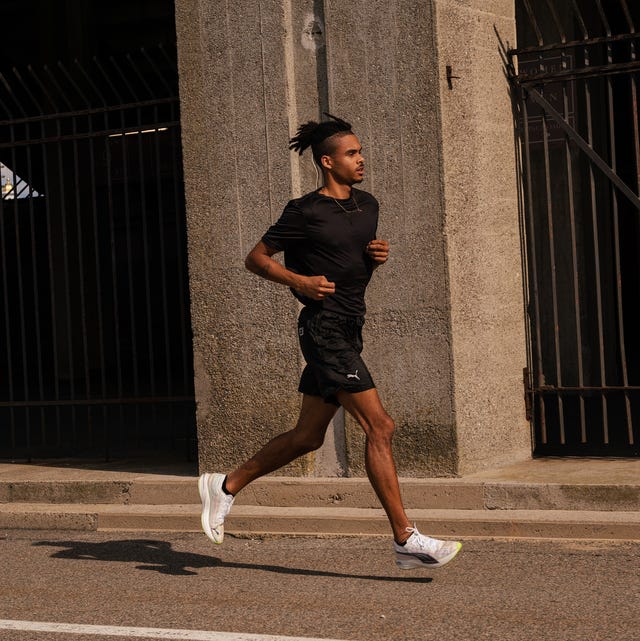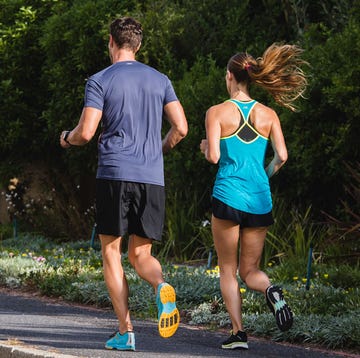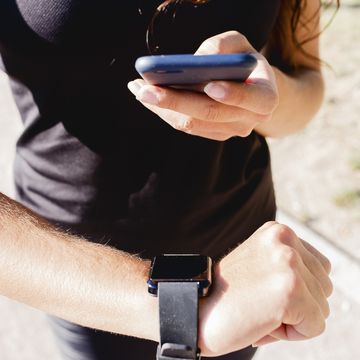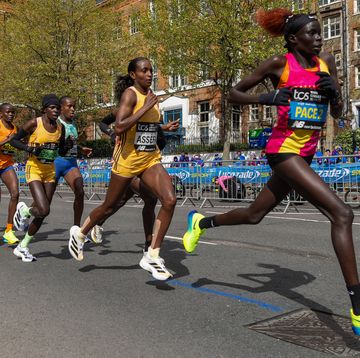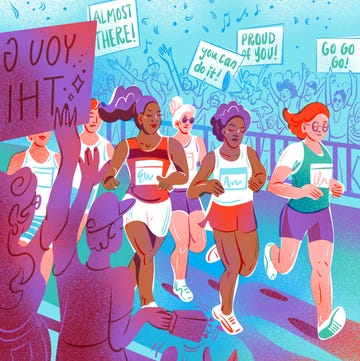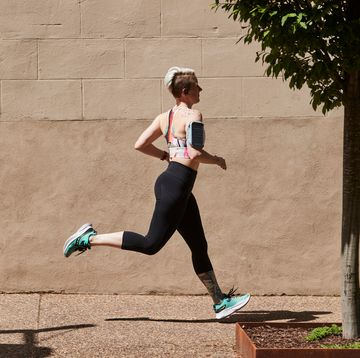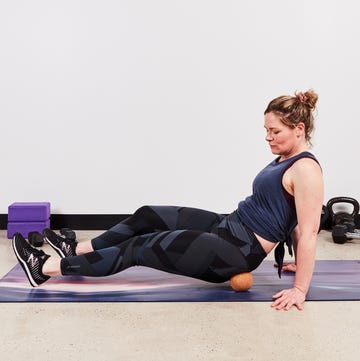If someone asks how many calories are burned when walking vs. how many calories are burned when running, it’s pretty commonly known that running burns more in a shorter period of time.
But there are way more benefits to running and walking than your calorie burn. Walking provides a lot of the same benefits as running, and it can be a valuable workout in its own right. For instance, a good walk can do wonders for your mental health, which is especially important during a global pandemic—research shows that just 30 minutes of walking per day can reduce symptoms of depression.
Here’s how the two activities stack up against each other.
Walking vs. Running: By the Numbers
Running one mile and walking one mile aren’t going to burn dramatically different calorie amounts, says Alex Harrison, Ph.D., a USA Track & Field-certified run coach and sport performance coach for Renaissance Periodization. However, it’s going to take you a lot longer to do the latter—and so the caloric difference between walking and running comes down to how many calories you burn per minute, not per mile.
A 160-pound person burns approximately 15.1 calories per minute running, according to the American Council of Exercise. That same person would burn approximately 8.7 calories per minute walking. For a 30-minute run, that works out to around 453 calories burned running compared to around 261 calories burned while walking for 30 minutes.
“There’s a difference in calories per mile between walking and running of maybe 10 to 30 percent depending on the conditions, a runner’s experience, etc.,” Harrison explains. “Running burns loads more calories per minute than walking because that mile that costs 10 to 30 percent more calories is being completed in as little as half the time.”
To estimate the amount of energy—remember, energy equals calories—the body uses during physical activity (versus when you’re at rest), scientists use a unit that measures the metabolic equivalent for task (MET). Your body burns one MET while lounging on the couch. Walking, a “moderate” exercise, uses 3 to 6 METs; running, which is typically classified as “vigorous,” uses 6 METs or more.
Here’s why that calorie burn is so different when you’re walking vs. running: “Muscle action that propels you from point A to B requires the utilization of a thing called ATP,” explains Janet Hamilton, C.S.C.S., an exercise physiologist and owner of Running Strong. “Your body stores only a limited amount of ATP (enough for only a few seconds of activity), so it needs to replenish that supply, and it does so by metabolizing your stored fuels (glycogen and fat). The process of making useable energy (ATP) from stored fuel (glycogen and fat) is dependent on how much you need and how quickly you need it.”
Translation: The more intense the activity, the greater the demand for fuel—and since walking is less intense and demanding than running, it doesn’t demand that ATP be produced at the same rate.
Running also has a slightly higher “afterburn” (or excess post-exercise oxygen consumption) effect than walking—meaning, your body will continue to burn calories after you’re done exercising until your body returns to its normal resting state. Research published in the The Journal of Strength & Conditioning Research found that the afterburn lasts five minutes longer for runners than it did for walkers.
That’s because the body requires energy to recover from exercise. “The greater the intensity and volume, the more calories will be burned after the exercise is completed,” explains Iain Hunter, Ph.D., a professor of exercise sciences at Brigham Young University. When exercising, you burn some of your stored fuels; replenishing those stores takes energy. Your body uses that energy to repair any microdamage from exercise as well.
Walking vs. Running: Which Is Better for Weight Loss?
From a weight loss perspective, running is the clear winner: When researchers compared 32,000 runners from the National Runners’ Health Study with 15,000 walkers from the National Walkers’ Health Study after about six years, they found that calories burned through running led to 90 percent more weight loss than calories burned through walking.
Fitness trackers and fitness equipment can tally your calories burned while exercising, but they’re not always accurate. “Using a variety of sources and taking a ‘midpoint’ might help keep you honest,” says Hamilton. “But all of these estimates of calories burned are just that: estimates. There are a lot of variables that go into the actual number of calories burned by any given individual in any exercise beyond speed and duration.”
For a starting point, calculate your numbers with our Calories Burned Running Calculator. Can you up those numbers? The more you weigh, the more calories you’ll burn, no matter the activity—that’s because it takes more energy to move more weight. Consider adding a weighted vest to your workout to up your calorie burn.
It’s simple physics: “The majority of calories burned in running [or walking] comes from supporting body weight while moving up and down,” says Hunter. “With more weight, there will be a greater energy cost in doing this due to a greater gravitational force.”
The same goes for intensity, too: Hiking or climbing stairs can actually bring your walking METs burn up to running levels.
“Greater muscle forces are required to move faster to accelerate the body up and down, move the limbs faster, and work against gravity,” says Hunter. “Running or walking uphill requires greater energy, just like lifting weights upward. It’s as if our body is the weight that we must move to greater heights, so the greater the slope, the greater the energy requirement.”
And then, of course, there’s speed: “Speed has a huge effect on caloric expenditure,” Hunter says. “The faster someone runs, the more calories they will burn per minute. However, by distance, there is a relatively steady amount of calories burned.”
For example, in 30 minutes of running at 6 miles per hour (that’s a 10-minute/mile pace), a 155-pound person will burn 372 calories. At 6.7 mph (or a 9-minute/mile), they’ll burn 409 calories, and at 7.5 mph (an 8-minute/mile pace), they’ll burn 465 calories. To double your calorie burn per mile, you’d have to literally cut more than four minutes off your pace, which is a huge amount of time.
It’s important to remember that while weight loss can “technically” be boiled down to “calories in must be less than calories out,” it’s not quite that simple. We are hardwired to survive famines, not to lose weight. We have hormones that make us feel hungry and hormones that make us feel full. When we eat less to try to lose weight, they flip to push us back to where we were, says says Deborah Horn, D.O., M.P.H., clinical assistant professor, McGovern Medical School at UTHealth in Houston.
“And as soon as you lose weight, your metabolism goes down by an average of 15 percent, and in some people more,” Horn says. Worse: Even if you regain weight, your metabolism may never completely recover.
Don’t Underestimate Low-Intensity, Steady State Cardio
Just because it isn’t as time- or energy-efficient as running doesn’t mean you should never look to walking as exercise. Whether you’re running or walking, you can reduce your risk of hypertension, high cholesterol, diabetes, and improve your cardiovascular health, according to data from the National Runners’ Health Study and the National Walkers’ Health Study.
“One benefit of the LISS [low-intensity, steady state] cardio approach for fat loss for runners is that they can actually add LISS like walking into their training plan when they’re already approaching their running limits for weekly mileage, and they won’t risk injury to the same extent they would if they were to just add running mileage,” says Harrison.
In fact, fast walking can actually help you raise your calorie burn to the same amount as what you’d burn jogging.
“The difference in calorie burn between briskly walking a mile and slowly running a mile is minimal,” says Hamilton. “Walking builds and maintains lower extremity and core strength, helps clear your mind, and, for runners, it’s a great way to have an active recovery day.”
To maximize calorie expenditure for the purpose of deepening a calorie deficit, you need to maximize the distance traveled or the total work done without causing hunger. For that reason, “running should not be used as a means of developing a caloric deficit,” says Harrison. “It takes too many miles, too much fatigue from those miles, and, most importantly, too much glycogen depletion, which is a surefire way to stimulate strong hunger and cravings.”
In that case, walking can be a more proactive way to weight loss than running.
“Slowing the pace to a walk would be a better means of burning calories while not depleting glycogen to the same extent, which will stave off hunger while still adding to the caloric deficit necessary for weight loss,” says Harrison. “Walking 20 to 30 minutes a couple times per day is best—it’s short enough that you don't get hypoglycemic during the walk, but much easier to do lots of times throughout the week, rather than higher-intensity work.”
The Bottom Line
In the end, vigorous running wins out for calorie burn, but remember that calories aren’t everything.
“‘Fitness’ and ‘caloric expenditure’ are two very different things,” says Harrison. “Fitness equals some level of cardiovascular exercise performance; calorie expenditure is how much mechanical and physiological work is actually done. It’s possible to do less calorie expenditure, and get a massive training stimulus for fitness improvement. Just think about a short, very intense 10 or 15 minutes of hard intervals—it’s probably not the best for weight loss, but will certainly cause a larger increase in fitness than longer bouts of walking or slower running.”
Obsessing over exactly how many calories you consume or burn is just as unhealthy as not exercising at all. So choose the activity you love the most—whether it be walking or running!—and focus less on the calories and more on how much better you feel after doing it.

